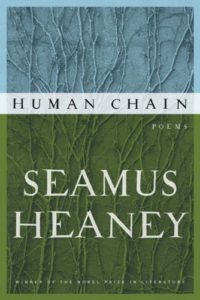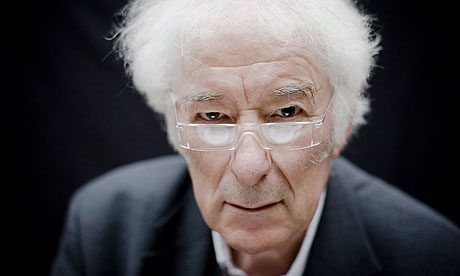
Of the few living recipients of the Nobel Prize for literature whose native language is English, only two are poets. One of those is Derek Walcott, and the other is Seamus Heaney. Ironically, both released new collections of poems in 2010 to wide acclaim. It is a treat (if a bit intimidating) to review a book of poems by someone whose status within the complicated discourse of poetry is not at all complicated—Heaney might be the most revered poet writing in English.
Human Chain, Heaney’s first book since his much-celebrated District and Circle (which won the British version of the T. S. Eliot prize in 2006) is also the first book since the poet suffered a stroke in that same year. The effects of the stroke on Heaney’s ability to put down a brilliant line seem to be negligent. Indeed, the poet Colm Tóibín claims that Human Chain is Heaney’s “best single volume for many years, and one that contains some of the best poems he has written.” It would appear that the poetry world stands in agreement, for Human Chain recently made the shortlist for the 2010 T. S. Eliot prize (Walcott won it), and it has received staggeringly strong reviews both in the US and abroad. In fact, so many high-profile writers have given the book so much high praise, I’m worried I have few high ideas to add to the conversation.
But, that’s really never stopped the reviewer before. No need for it to now.
I found myself intrigued by all of the energy surrounding what people seem to be calling a renewed energy in Heaney’s work. This made me think, of course, of his fellow countryman, William Butler Yeats, whose poetic prowess late in his life is legendary. But, for this and several other reasons, Human Chain made me think of Wallace Stevens who may have done his best work in his sixties. Like Stevens, Heaney’s poetics have calmed since he was a youngster. His phrasings boast fewer pyrotechnics, and his topics veer toward the meditative, the mournful, and the missing. Also like Stevens, Heaney has cottoned to the tercet—the three-line stanza made famous by Dante and nearly perfected by Stevens. I find the tercet a difficult stanza to execute (yes, I intend both connotations). The couplet and the quatrain are more symmetrical, more grounded, while the tercet always feels in danger of losing its balance, but like a waltz, a sure-footed dancer can make the three-stepped movement seem graceful and counterpoised.
“’Had I Not Been Awake’,” the collection’s opening poem, is a nice example of what I’m talking about:
Had I not been awake I would have missed it,
A wind that rose and whirled until the roof
Pattered with quick leaves off the sycamoreAnd got me up, the whole of me a-patter,
Alive and ticking like an electric fence:
Had I not been awake I would have missed it,It came and went so unexpectedly
And almost it seemed dangerously,
Returning like an animal to the house,A courier blast that there and then
Lasped ordinary. But not ever
After. And not now.
I love looking closely at the first poem in a book. It’s a bit like the opening scene of a movie or the first cut on an album. It sets the stage for the whole work. It can bring the reader in or turn her off. There is a lot of pressure to get it right. Unless of course you’re Seamus Heaney, in which case, the reader assumes that if your opening poem is lame, you’re intentionally under-writing so that you can deliver the whallop later.
Thankfully, that’s not the case here. What the poem lacks in edginess it makes up for in description and in the master poet’s ability to capture a moment. The poem revels in its came-and-went-ness/it-was-here-but-now-it’s-gone-ness. Poetry has always relied on its facility to notarize, memorialize and allegorize the instantaneous, and no one is better at this than Heaney, except maybe a young William Carlos Williams. But, Williams’s moment poems function largely as snapshots; whereas Heaney’s work more like snippets of film. Here, the speaker (Heaney?) uses narrative to circumscribe the moment rather than capture it.
The literary critic Albert Gelpi made one of the single most insightful observations about Walt Whitman and Emily Dickinson. According to Gelpi, both poets are obsessed with the self but in opposite ways. For Whitman, the self is circumference; for Dickinson the self is center. By this he means, Whitman’s poetic self is expansive—it radiates out, encircling everything. But for Dickinson, the self is centripetal; it sucks everything inward into its box-like poems. I have always found Heaney more Dickinsonian than Whitmanian. His is a controlled poetry of interior spaces. Sure, there’s the bog, but the bog is like, super centripetal.
Notice here how the movement of the poem draws inward.
Not missing the wind is more noteworthy than the wind. Which is to say, the poet’s perception, that centering mechanism, establishes itself as the poetic focal point. One reason this might be the case is the potentially autobiographical (and therefore allegorical) nature of the poem. “Had I Not Been Awake” might very well be code for “Had I Not Been Alive.”
Oddly enough, it’s the wind that supports this reading.
For William Wordsworth and pretty all much all of the Romantic poets, wind is big. Think of Shelley’s “Ode to the West Wind,” Keats’s “The Winter’s Wind,” Byron’s “You Are the Wind Beneath My Wings” (wait, that’s Bette Midler). Regardless, for British poets more than American ones, wind has served as a potent symbol for the creative imagination in general and as it applies to poetry in particular. It’s a “gentle breeze” that initiates Wordsworth’s Prelude and connects the entire work. Later, the wind, like the poem gets out of control, perhaps a bit like the wind outside Heaney’s window. So, when the poet repeats, “Had I not been awake, I would have missed it,” it seems impossible to read the poem any other way but: Had I not been alive I would not have written this poem or this book. I would have missed poetry.
And so one tends to see the book entire through that lens, with that level of urgency. Elegies for those who have died take on new weight (how many of us will memorialize Heaney when he passes?), observations of emotion carry greater nuance, descriptions of family and place seem valedictory, and memories rise to the level of myth.
The book’s second poem, “Album,” also in tercets, is a four-part recollection of youthful days. The poet’s past, though, is not elegized; rather it’s recalled with what we might describe as sensorial brevity. Unlike Wordsworth, who tended to romanticize his childhood experience (he made it both expansive and epic) Heaney opts for a clipped, almost post-it-note aesthetic. The effect strips the poem of sentimentality but not of sentiment. In “The Conway Stewart,” the poet recreates in mostly three and four-word lines, the experience of a shopkeeper demonstrating a
Medium, 14-carat nib,
Three gold bands in the clip-on screw-top,
In the mottled barrel a spatulate, thinPump-action lever
That moment, what Wordsworth called a “spot of time,” becomes a metonym for the speaker’s departure. Similarly, in “’Lick The Pencil’” (I’m not joking; that really is the title), we discover that “Lick The Pencil” is the nickname for a classmate of the poet’s:
“Lick the Pencil” we might have called him
So quick he was to wet the lead, so deft
His hand-to-mouth and tongue-flirt around the stub.Or “Drench the cow,” so fierce his nostril-grab
And peel-back of her lip, so accurately forced
The bottle-neck between her big bare teeth.Or “Catch the horse,” for in spite of the low-set
Cut of him, he could always slip an arm
Around the neck and fit winkers on
We should be up front here and acknowledge that on one hand, this might very well be an innocent poem about childhood, but on the other, it might also be just really dirty. “Lick the pencil?” “Hand-to-mouth and tongue-flirt around the stub?” If “wet the lead” does not make it into the Larry David/Judd Apatow parlance of permissible vulgarities, it will be a missed opportunity.
I’m having fun with Heaney’s unintentional double entendres, but, don’t hold that against him. Despite my grade school humor, there is an easy dignity in these poems that few living poets are able to embody. Whether it’s one of the memory recollected in tranquility poems or his description of landscape or his willingness to enter the complex emotions that come when one makes the past part of the emotional present, Heaney’s consistent tone makes everything feel that much more poetic.
One final note. I would call attention to something I never see critics talk about: Heaney’s slipperiness. It is this very component–the slipperiness of Heaney’s poems–that make them so compelling. They are never about one thing. They are always about two and probably also three or four. Layer upon layer gets excavated with each reading. And the seeming simplicity of this collection simply adds to its richness. It’s the perceived gap between surface appearance and structural depth. It’s the work of a master who is not obsessed with proving he’s a master.





